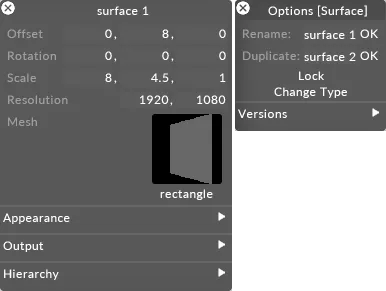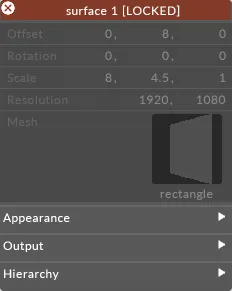Managing Objects
Right-clicking the title bar of a standard object editor will open the Object options menu.
 Object options menu for a Screen
Object options menu for a Screen
Renaming an object
Section titled “Renaming an object”The first option is rename, followed by an editable text field.
To rename an object, type the name of the object in the rename text field and hit Enter (or click the ok button to the right of the text field). If the new name already exists, a small message will pop up explaining this.
Duplicating an object
Section titled “Duplicating an object”The second option is duplicate , followed by an editable text field.
To duplicate an object, type the name of the object in the duplicate text field and hit Enter.
Locking and unlocking an object
Section titled “Locking and unlocking an object”Objects can be locked to prevent other users from accidentally editing their contents. A locked object shows a red title bar with the word [LOCKED] appearing to the right of the object name.
 Locking an object prevents other users from accidentally editing their contents
Locking an object prevents other users from accidentally editing their contents
A locked object can still be edited to test what happens when you edit its properties. However, the modified properties will not be saved when exiting d3. Unlocking the object will cause the values to be saved as normal.
To lock an object, left-click lock from the Object options menu.
Unpacking an object
Section titled “Unpacking an object”For step-by-step instructions on how to import/export objects and from one project to another, please see the Importing/ExportingBetween projects.
Rolling back an object to a previous version
Section titled “Rolling back an object to a previous version”The final option in the Object options menu, roll back, is used to roll back an object to a previous version.
Any time you exit the software, the state of every object is saved. Hitting Alt-W will also save the state of every object in the software (only objects that have changed will be saved). Every object stores the previous seven versions, including date-stamps, for when they were created.
To rollback an object to a previous version:
- Open the objects editor and right-click the title bar. This will open the Object options menu.
- Select rollback from the Object options menu, then you will see a list of version date-stamps.
- Left-click the date-stamp you want to roll the object back to.

The software saves the last seven versions of an object with their date-stamps, opened by right-clicking an objects title bar and left-clicking Rollback
If the object cannot be roll-backed because it has been deleted, or the current .d3 Project file becomes corrupted or otherwise fails to load, it is possible to revert to a previous version of the .d3 Project file. For information on this feature please see the above sub-chapter Project structure.
For information on how to use the other options from the Object options menu please see editing objects topic.